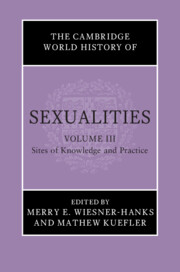Book contents
- The Cambridge World History of Sexualities
- The Cambridge World History of Sexualities
- The Cambridge World History of Sexualities
- Copyright page
- Contents
- Figures in Volume III
- Tables in Volume III
- Contributors to Volume III
- Editors’ Preface to the Series
- 1 Sex in Athens in the Fifth and Fourth Centuries bce
- 2 Sex in Rome in the First Century bce and the First Century ce
- 3 Sex in Constantinople in the Sixth Century ce
- 4 Sex in Chang’an in the Eighth and Ninth Centuries ce
- 5 Sexuality in Baghdad in the Ninth and Tenth Centuries ce
- 6 Sex in Heian-kyō (Kyoto) in the Tenth through Twelfth Centuries ce
- 7 Sex in Iceland in the Fourteenth and Fifteenth Centuries ce
- 8 Sex in Florence in the Fifteenth Century
- 9 Sexuality in Tenochtitlan in the Early Sixteenth Century
- 10 Sex in Sixteenth-Century Istanbul
- 11 Sex in Geneva in the Sixteenth Century
- 12 Sex in Eighteenth-Century Edo (Tokyo)
- 13 Sex in Eighteenth-Century Paris
- 14 Sex and Sexuality in Eighteenth-Century Philadelphia
- 15 Sex in Nineteenth-Century Cairo
- 16 Sexual Pleasures and Perils in Nineteenth-Century London
- 17 Sex in Manila in the Late Nineteenth and Early Twentieth Centuries
- 18 Sex in Lagos from the Mid-Nineteenth to the Mid-Twentieth Century
- 19 Sex in Bombay in the Late Nineteenth and Early Twentieth Centuries
- 20 Sexuality in a Distant Metropolis: Buenos Aires from the Late Nineteenth to the Mid-Twentieth Century
- 21 Sex in Early Twentieth-Century Berlin
- 22 Sex in Sydney in the Twentieth Century
- 23 Toronto the Good, Toronto the Gay: Sex and Morality in the Twentieth Century
- 24 Sex in Shanghai in the Twentieth Century: Intimate Negotiations
- 25 Sex in Twentieth-Century Rio de Janeiro
- Index
- CONTENTS TO VOLUMES I, II, AND IV
- References
10 - Sex in Sixteenth-Century Istanbul
Published online by Cambridge University Press: 26 April 2024
- The Cambridge World History of Sexualities
- The Cambridge World History of Sexualities
- The Cambridge World History of Sexualities
- Copyright page
- Contents
- Figures in Volume III
- Tables in Volume III
- Contributors to Volume III
- Editors’ Preface to the Series
- 1 Sex in Athens in the Fifth and Fourth Centuries bce
- 2 Sex in Rome in the First Century bce and the First Century ce
- 3 Sex in Constantinople in the Sixth Century ce
- 4 Sex in Chang’an in the Eighth and Ninth Centuries ce
- 5 Sexuality in Baghdad in the Ninth and Tenth Centuries ce
- 6 Sex in Heian-kyō (Kyoto) in the Tenth through Twelfth Centuries ce
- 7 Sex in Iceland in the Fourteenth and Fifteenth Centuries ce
- 8 Sex in Florence in the Fifteenth Century
- 9 Sexuality in Tenochtitlan in the Early Sixteenth Century
- 10 Sex in Sixteenth-Century Istanbul
- 11 Sex in Geneva in the Sixteenth Century
- 12 Sex in Eighteenth-Century Edo (Tokyo)
- 13 Sex in Eighteenth-Century Paris
- 14 Sex and Sexuality in Eighteenth-Century Philadelphia
- 15 Sex in Nineteenth-Century Cairo
- 16 Sexual Pleasures and Perils in Nineteenth-Century London
- 17 Sex in Manila in the Late Nineteenth and Early Twentieth Centuries
- 18 Sex in Lagos from the Mid-Nineteenth to the Mid-Twentieth Century
- 19 Sex in Bombay in the Late Nineteenth and Early Twentieth Centuries
- 20 Sexuality in a Distant Metropolis: Buenos Aires from the Late Nineteenth to the Mid-Twentieth Century
- 21 Sex in Early Twentieth-Century Berlin
- 22 Sex in Sydney in the Twentieth Century
- 23 Toronto the Good, Toronto the Gay: Sex and Morality in the Twentieth Century
- 24 Sex in Shanghai in the Twentieth Century: Intimate Negotiations
- 25 Sex in Twentieth-Century Rio de Janeiro
- Index
- CONTENTS TO VOLUMES I, II, AND IV
- References
Summary
This chapter traces the inflection of various religio-cultural traditions and customs of erotic love and sex and ordering of sexual acts in sixteenth-century Istanbul as defined by literary and documentary sources. With its diverse population and as the seat of the Ottoman dynasty, Istanbul was one of the most crowded and diverse cities of the sixteenth century. It witnessed the formation of an elite class that distinguished itself from the majority of the urban population through ideological othering strategies and the establishment of law codes to order and rule the diverse communities in the city. Literary works that focused on the city and documents, including law codes and court records, reflect conflicting views on sexual relations: while chaste love among members of the elite was idealized in romances and sexual acts were criticized in satirical works, documents reflected the ways sexual acts and desires were regulated, controlled, and punished.
- Type
- Chapter
- Information
- The Cambridge World History of Sexualities , pp. 191 - 209Publisher: Cambridge University PressPrint publication year: 2024



